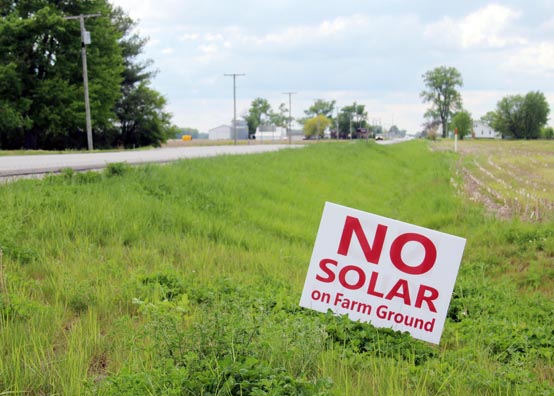By HOLLY GASKILL
A solar farm seeking an “overlay district” for electricity production in Wells County has become subject to significant debate and speculation, garnering high attendance at county government meetings, as well as petitions and public protests calling for “No Solar on Wells County Farm Ground.”
Paddlefish Solar LLC has secured land leases for 3,413 acres spanning across southern Wells County and into Huntington County for its solar development. If approved, the project will last for roughly 40 years.

While this recent zoning application has garnered the most public interest thus far, the project has roots spanning back to 2019, when Director of Community Relations Trena Roudebush said the company first began seeking leases.
According to Roudebush, the area was identified due to its proximity to existing electrical utilities and suitability for solar development. “What makes the land good for farming is what also makes it good for solar,” she explained. Roudebush stated that 5-6 acres in Indiana can produce one megawatt of energy through solar — the same output would require nearly 10 acres in Kentucky.
Geenex, a solar company based out of North Carolina, was initially solely handling the project. Paddlefish Solar was later acquired by EDF Renewables, an energy company owned by the French government. The companies have continued to work together until the project’s construction.
Paddlefish Solar first began negotiating with local officials in 2021, Roudebush said. In September 2021, the Area Plan Commission was also notified that the project would apply for an overlay district “very soon.”
Roudebush said conversations at the time seemed “very positive” and that the Wells County Commissioners expressed sentiments that the county had “missed an opportunity” when a wind farm had been dropped nearly 10 years prior.
Paddlefish Solar has since received a unanimous “do not pass” recommendation from the APC for its zoning application. The commissioners have until June 6 to either follow or overturn the APC’s ruling.
Commissioners Jeff Stringer and Blake Gerber told The News-Banner that this statement from Roudebush was not accurate.
Stringer said he’s taken negotiations step-by-step, intending to broker competitive agreements that would set a precedent for future interest from renewable energy companies. Meanwhile, Gerber stated there was interest in what the potential money could do for the county, but had felt the wind turbine discussions had ended with a “sigh of relief” when it failed.
The News-Banner was unable to reach Commissioner Mike Vanover about Roudebush’s statements by print deadline.
Tax Abatement
In December 2022, Paddlefish received approval for a 10-year total tax abatement from the Wells County Council. The council at the time voted 5-2 in favor of the abatement; Jim Oswalt and Vicki Andrews, the board’s only two residents in the affected Chester and Liberty townships, were opposed.
The abatement only applied to the equipment on the land, not the land itself, which would be taxed at a higher rate for energy production.
In exchange, Paddlefish agreed to issue a series of economic development payments totaling at least $8.5 million. These payments reportedly would have accrued roughly 85% of what would have been collected through taxes but without the same restrictions as tax funding.
Officials gave no specific plans for the payments but alluded to several needs related to emergency services. Representatives from Southern Wells Community Schools also advocated for a portion of the funds, which would have otherwise more significantly benefited their tax levy.
In the abatement agreement, Paddlefish pledged to invest at least $250 million in the project, which would then be fully taxable after 10 years.
The commissioners also approved the economic development agreement 2-0; Vanover was absent. At the time, Stringer stated, “For me, it’s not about pro-solar or anti-solar, it’s about pro-individual rights. I don’t believe that we have the right to tell you what you can and can’t do on your ground. We just need to make sure that taxpayers are equally taken care of by their governments.”
Paddlefish has since been criticized for receiving an abatement in addition to federal credits for solar development.
“They are only necessary to level the playing field,” Roudebush stated about federal credits. “So, all forms of general energy generation — coal, gas, oil — they all receive government subsidies. So for us to be competitive financially, we need similar considerations.”
To this effect, Roudebush initially stated that an abatement frees up some money for the company amidst a the company a $250 million-plus upfront investment. She did, however, recognize that $10 million in property taxes is a fraction in the context of the total project.
“If those weren’t (approved), we could also do without, but I think the biggest impact that those assistance mechanisms have is keeping our energy prices low,” Roudebush said.
Road Use and
Decommissioning Agreements
The County Commissioners then unanimously approved road use and decommissioning agreements with Paddlefish in December 2023. These documents outlined protections for the county regarding the set-up and eventual tear-down of the solar development.
Paddlefish agreed to a two-year “restoration period,” where the company would have to “restore the land substantially to the same condition prior to construction,” the document states. To ensure this process is honored, Paddlefish will submit a decommissioning security based upon a mutually agreed-upon engineer’s estimate of decommissioning costs with contingency.
The decommissioning agreement includes provisions that, should a major event stop energy production, Paddlefish would have 12 months to restart operations and prove they would be “substantially operational” within another year. If the county found this unsatisfactory, decommissioning would begin within six months.
Paddlefish also agreed to pay for road damages caused by the project.
“These agreements only add protection to Wells County — there is no risk,” summarized Paddlefish project manager Jesse Laniak at the time.
Overlay District
In March 2024, the APC unanimously agreed to send a “do not pass” recommendation to the County Commissioners for an overlay district requested by Paddlefish for 49 parcels of land. The P-1 district overlay would allow agriculturally zoned land to be used for energy development.
The board heard presentations from Paddlefish and the public for approximately four hours until board member Chandler Gerber made a motion for the recommendation, saying approval of the project felt inconsistent with the Wells County Vision 2035 Comprehensive Plan.
The comprehensive plan, which was formed through an extensive effort by multiple governing bodies, states that all jurisdictions should consider the lack of public support for utility-scale solar energy and the desire to preserve an agricultural community.
As the item proceeded to the county commissioners, an outpouring of support from both sides flooded the meeting. The commissioners ultimately deferred action, with Gerber saying they had to do their due diligence in considering all aspects of the request.
Paddlefish in
Huntington County
A relatively small portion of the Paddlefish project will span into Huntington County, where officials are in a much different position. According to Huntington County APC Executive Director Kim Hostetler, Paddlefish did not have to go through a zoning hearing process because their local agricultural zoning permits solar energy development.
Paddlefish has, however, been approved for similar abatement, road use and decommissioning agreements, all of which also passed.
Most recently, Paddlefish received three variances, allowing the company to eliminate setback requirements across properties, increase solar panel height from 12 to 16 ft., and place a collection system underground across a public right-of-way or drainage easement. Roudebush said these variances were requested so the development could continue without separation over directly adjacent parcels.
Hostetler said Paddlefish will next need to apply for development plan approval with Huntington County.
EDF Renewables also has another project, Bowfin, near the Paddlefish site in Huntington County. Hostetler said the county has not received any applications from that project but “the majority of people are fired up about it.”
Meanwhile, the 150-acre solar project from Narenco, a company based out of North Carolina, has already received development plan approval and is moving toward building permits, Hostetler said.
Project Specifics
Paddlefish holds 40-year leases from 12 property owners for 49 parcels of land in Wells County.
Representatives from Paddlefish have stated that only 1,800 acres of their leased land in Huntington and Wells counties will be within a fenced area. Panels will cover approximately 45% of the remaining acreage to allow the panels to rotate and maintenance vehicles to pass through as needed.
Roudebush said the panels will be held into the ground by their poles without concrete. Concrete will only be poured at a substation, which transmits and distributes electricity. The site will generate 350 megawatts for the regional power grid system, powering roughly 64,000 homes.
Roudebush also advised that Paddlefish will use agricultural fencing 20 ft. from the panels, then “vegetative screening” from trees and shrubs roughly 20 ft. from the fence. Paddlefish will use a 450 ft. setback from any dwelling. With this in mind, Roudebush said the development should be “low profile.”
Down the line, all of these items will be removed or restored to their original state per the decommissioning agreement. Roudebush additionally emphasized that preserving and repairing drainage is a priority of the company, not only for the landowners but also because the development itself will need well-draining land.
Roudebush further stated that selling carbon credits, a method of offsetting carbon emissions, is “not contemplated in the financial model.” Furthermore, should EDF Renewables sell Paddlefish to another company, all current agreements would remain in place.
Paddlefish has not yet reached the stage of submitting a formal development proposal, however. The company website states construction is planned for 2026-27 and operation beginning in 2027-28.
Public Response
Support and criticism of Paddlefish have ranged widely among Wells County and northeastern Indiana residents.
In recent months, the Facebook group, “No Solar on Wells County, IN Farm Ground” has spearheaded efforts to place anti-solar signs throughout the county and planned a protest preceding the Republican primary candidate forum in April. The group has also coordinated widespread attendance at government meetings in Huntington and Wells counties.
During these events, those opposed to the development have cited numerous complaints, predominantly issues with the possibile weakening of the agricultural community and industry, concerns about property values and a general dislike of solar farms.
In response, Roudebush claimed that the Paddlefish project represents about 0.6% of farmland in Wells County and 1.5% in Huntington County. She also referenced studies of property values near solar farms indicate no significant change. “(Neighbors will) find that these do make good neighbors. They don’t make noise. They don’t bring traffic,” she said.
Roudebush attributed misinformation to some of the vitriol for solar energy.
Supporters of the project have emphasized the property owners’ rights, the potential economic value to the county and future energy needs.
Roudebush added, “For the last several generations, we’ve entrusted our farmers and our landowners to do what is right for their family and for their property. And at the end of the day, it’s the same.”
What’s Next
According to Wells County APC Executive Director Mike Lautzenheiser, the commissioners have until June 6 to vote in favor or against the overlay district or the request will be automatically rejected.
After delaying their vote, the commissioners expressed they would not vote on the matter until “at least May” to review their legal options. Roudebush told The News-Banner there would not be a penalty to the county should they vote against the zoning request.
“All of the agreements that have been done so far — the road use agreement, decommissioning, economic development — they’re all to the benefit of the county, should the project be permitted,” she said.
Both Stringer and Gerber have expressed negative sentiments about the project. Stringer claimed Paddlefish representatives had informally requested to extend the consideration period and asked what was needed to make things work. Gerber made similar comments, adding that he “had no interest” in continuing the conversations with Paddlefish.
If the request is rejected, Roudebush said there is a “timeout” period before the company could refile. During that time, she said “it would be EDF deciding on whether we see a path forward down the line at some point, or if this is the end of this horrible, vicious road, and we move on to other opportunities. There would be a lot to be contemplated.”
Meanwhile, Paddlefish has extended a $750 annual electricity credit to 49 adjacent properties for the first 15 years of the project. Should all properties participate, this would be over $550,000 in total toward the area property owners. Residents were asked to sign up by June 1 to receive the credit.
The Huntington County Commissioners are also reportedly slowing their processes, taking time to meet with the APC, Paddlefish representatives and property owners affected by the potential development.
That said, Gerber indicated the conversation about solar energy at large may be ongoing, as several other companies have reportedly secured land leases in both southern and northern Wells County.
holly@news-banner.com



